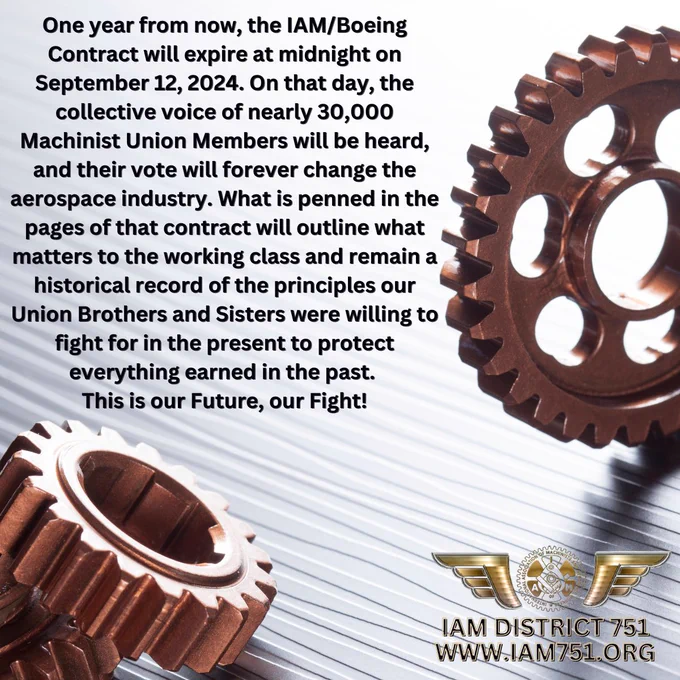Leeham News and Analysis
There's more to real news than a news release.
Pontifications: IAM 751 gearing up for Boeing contract talks in 2024
Sept. 19, 2023, © Leeham News: It’s September 2023, one year ahead of the expirations of the current labor contracts between Boeing and its touch labor union, IAM 751. (The contract with the engineers union, SPEEA, expires in 2026.)
The IAM district, whose members assemble all Boeing airplanes in Washington State, fired a warning shot across Boeing’s bow last week. It wasn’t the first.
751 urged its members to begin saving money in anticipation of a strike in September 2024. That was three years ago.
The strike fund information appeared in the 751’s March 2020 newsletter, Aero Mechanic. The same issue had commentary about the new pandemic. At that point, nobody thought the pandemic would last two years.
Boeing was already in trouble then. The 737 MAX had been grounded since March 2019. There was no end in sight when the grounding would end. Suspension of the 787 deliveries, for what became 20 months, was still another half-year away.
Pontifications: History is repeating itself
Sept. 5, 2023, © Leeham News: Decades after US airline unions were on the decline, some are making big gains in restoring wages, benefits, and strength.
Pilots at American, Delta, United, and Alaska airlines (among others) won big wage increases under recent contract negotiations. Pilots at Southwest Airlines are aggressively seeking more money and revised work rules. Flight attendants at American just approved a strike authorization by a wide margin.
Drivers at UPS Airlines, the package-freight carrier, won a generous new contract. Pilots at rival FedEx also became more militant in recent months.
One can hardly blame the unions for seeking dramatic wage hikes and work rule changes. Labor has been under constant pressure since the 1970s. Unions probably reached their peak strength in 1966, when five US airlines were struck at the same time by the International Association of Machinists and Aerospace Workers (the IAM). Sixty percent of the capacity was grounded for 43 days. Eastern, National, Northwest, Trans World and United were affected.
The industry was highly regulated. The Civil Aeronautics Board, created in 1938, oversaw virtually everything airlines did. Routes, airfares, serving alcohol, classes of service, and mergers were tightly controlled by the CAB. So was the competition. From its inception to 1978, the CAB turned down every single application to create a new airline (except a host of local service carriers immediately following World War II) or to upgrade charter carriers to scheduled service. More than 70 applicants were turned down.
Pontifications: One step forward, two steps back: Déjà vu all over again.
Aug. 29, 2023, © Leeham News: It’s déjà vu all over again.
Last March, I wrote a piece entitled One Step Forward, Two Steps Back discussing Boeing’s efforts to climb out of the very deep hole dug by the 737 MAX grounding, suspension of 787 deliveries and the pandemic.
I noted that for every step forward, something seems to happen to set it back two steps. (A Boeing official suggested the piece should have been two steps forward, one step back, but the underlying point is made.)
The backward steps seem out of Boeing’s control. But it’s Boeing’s name on the side of the airplane and its Boeing that delivers airplanes to the customers. It’s Boeing with whom customers are frustrated.
The latest step backwards that delays deliveries again of the 737 MAX comes from Spirit AeroSystems. Misdrilled holes for the aft pressure bulkhead are blamed this time. The full extent of the flaw, with impacts, number of planes affected, etc., is still being assessed at this writing. Spirit says a supplier is responsible for this issue.
This follows a previous setback when Spirit found that one of its suppliers provided parts that failed to meet specifications which attached the vertical tail to the fuselage of the 737.
These flaws, revealed within months of each other, negatively impact the delivery of new production 737s and delivery of some of the more than 200 MAXes that remain in inventory due to the 2019 21-month grounding of the MAX.
Before that, Spirit’s quality control on the 787 nose section it builds for Boeing was found to have flaws. Deliveries were suspended for nearly 20 months. Eventually, Boeing had 110 newly built 787s in inventory that require rework. The inventory won’t be cleared until the end of next year.
Pontifications: A little math for 777X, 737 MAX
Aug. 22, 2023, © Leeham News: We have a follow up to our Aug. 9 post about Boeing revealing the sub-type orders for the first time for the 737 MAX and 777X.
Boeing every month updates its website data for gross orders, cancellations and orders classified under an accounting rule called ASC 606. ASC 606 means orders are “iffy” for contractual or financial reasons with the customer.
The difference between gross orders and net orders represents cancellations, for whatever reason. The airline or lessor may have decided to cancel outright. Some orders might have been swapped within the family (for example, from a 737-8 to a 737-10). Some orders may have been swapped (cancelled) between models—for example, from the MAX to the 787. Boeing’s cumulative statistics haven’t revealed the difference between gross and net orders—until now.
ASC 606-classified order adjustments are excluded from the gross/net tally, Boeing tells me. In other words, for purposes of the tallies, the ASC 606 orders remain included in the gross numbers. They’re still orders at this stage, even if iffy. Airbus, operating under European accounting rules, doesn’t have to identify its iffy orders; LNA has made its best estimate for years of Airbus “iffy” orders, however, in an effort to level the publicly reported playing field. There are times when discussing orders and backlogs that we ignore Boeing’s ASC 606 classification when comparing with the Airbus orders.
With this as background, let’s get to the follow up to the Aug. 9 post.
Pontifications: Off the beaten path museums
Aug. 15, 2023, © Leeham News: If you’re in the Puget Sound area (the greater Seattle-Tacoma region) and want to see some well-preserved airplanes that are off the beaten path, take a run down to the McChord Air Force Base south of Tacoma.
McChord was created before World War II. Through the decades, it’s been a fighter, bomber, transport, tactical and strategic base. Today, it’s home to only the Boeing C-17 cargo transport. Refueling tankers are inland at Fairchild AFB near Spokane (WA). Fighters are no longer at McChord; they are stationed at an air base near Portland (OR). (This is why I think McChord should be “BRACed” (declared surplus) and turned over for civilian use as a commercial airport, but this is another topic.)
I visited McChord last week to see its museum and its aircraft static displays. The museum is a small building with artifacts, models, photographs and history. As museums go, I’ve seen better, but there’s interesting information here that serves as a good introduction to the air park (called Heritage Hill) where 16 aircraft are located.
Pontifications: Freighter outlook for the next 20 years
Aug. 8, 2023, © Leeham News: The cargo conversion market faces the prospect of oversupply of certain types, the consulting firm IBA said last week in a webcast.
The aftermarket conversion of Boeing 737-800s is already at 60 this year, according to IBA’s estimate.
The forecast doesn’t extend beyond this year—and therefore is incomplete. IBA notes that the Airbus A321 P2F supply is a fraction of the 737-800 conversions, which are undertaken mainly by Boeing and aeronautical Engineers Inc (AEI). There are more than 100 A320 family conversions orders (all but a handful for the A321) that will be coming on line in future years.
Likewise, IBA’s forecast for widebody conversions doesn’t extend beyond this year. There are also more than 100 orders for Airbus A330ceo conversions (all but a handful for the A330-300). Figure 2, like Figure 1, paints an incomplete picture.
Pontifications: The see-saw remarketing of China’s 737 MAXes; Air India gets 55
Aug. 1, 2023, © Leeham News: Air India is taking 55 Boeing 737 MAXes originally built for Chinese airlines and lessors, LNA has learned. These are part of the order announced in February for up to 150 MAXes. The order was finalized during the June Paris Air Show.

Two of 140 Boeing 737 MAXes built for Chinese airlines in storage at Moses Lake (WA). Boeing sold 55 of these Chinese airplanes to Air India, resulting in the dramatic drop disclosed during the second quarter earnings call. Credit: Leeham News.
This deal accounts for the sharp reduction in inventoried MAXes reported last week during the Boeing 2Q2023 earnings call. It also represents another development in the see-saw saga of whether to remarket the 140 MAXes built for China.
First, Boeing was going to remarket around 140 737 MAXes ordered by Chinese airlines and lessors but which remained in inventory due to Beijing’s refusal to authorize delivery.
Then, a mere three months later, Boeing CEO David Calhoun—who announced the remarketing effort in the first place—said Boeing would pause remarketing the aircraft.
Pontifications: Book Review: “Turnaround Time” at United Airlines
Turnaround Time: United an Airline and Its Employees in the Friendly Skies, by Oscar Munoz with Brian DeSpinter. $32.00. Available on Amazon and other outlets.
 July 25, 2023, © Leeham News: Oscar Munoz had been the chief executive officer of United Airlines only about a month when he suffered a massive heart attack that almost killed him. His heart was in such bad shape that he needed a heart transplant.
July 25, 2023, © Leeham News: Oscar Munoz had been the chief executive officer of United Airlines only about a month when he suffered a massive heart attack that almost killed him. His heart was in such bad shape that he needed a heart transplant.
Munoz was an executive of the railroad company CSX, and on the UAL Board of Directors, scandal erupted at United. Jeff Smisek, the CEO who took over United from the same position at Continental Airlines when UAL and Continental merged in 2010, had agreed to add service between Newark (NJ) and a South Carolina city to appease an executive of the Port Authority of New York and New Jersey. The Port owns and operates Newark (and New York’s LaGuardia and JFK airports). The emerging scandal led to the removal of Smisek, and others involved.
Munoz was a reluctant and somewhat odd choice. He had no airline experience, other than being on the Continental and later United boards of directors. He was in line to become CEO of CSX. He initially turned down being considered for the United CEO position when approached by a fellow UAL Board member. But with the Port Authority scandal, and a broken United which had not fully integrated the merger with Continental, he relented.
Munoz tells his story in Turnaround Time: United an Airline and Its Employees in the Friendly Skies. This newly published book is a combination of an autobiography and the turnaround of a troubled United.
Pontifications: NASA pulls the plug on electric airplanes
Some odds and ends after three weeks on the road.
- NASA pulls the plug on electric airplane research.
- NASA and Boeing’s Transonic Truss Brace Wing contract.
- Engines and the TTBW.
July 18, 2023, © Leeham News: When NASA gives up on a project, it’s time for others to take notice.
The agency is best known for space travel. But it funds and undertakes research and development for aeronautics, including commercial aviation. NASA, after all, is the acronym for National Aeronautics and Space Administration. Boeing, and Airbus, benefitted from NASA research in the past. NASA currently is working with Boeing on the transonic truss brace wing concept (TTBW) that could redefine how airplanes are designed and look as early as the end of this decade.
So, what has NASA abandoned? Late last month, the agency pulled the plug on the X-57 electric airplane before the first flight. NASA concluded that the electric and battery technology for the X-57, a small airplane, is too dangerous. NASA wouldn’t even authorize test flights.
It’s worth noting that LNA’s Bjorn Fehrm, an aerospace engineer, called bullshit on electric airplanes in his first of a series of articles way back on June 30, 2017. Billions of dollars have funded some 200 companies pursuing electric airplanes. This is money that could have been invested in expanding production of Sustainable Aviation Fuel, the leading alternative of alternative energy projects.
The current, continued frenzy over alternative energy vehicles is like the 1990s dot com frenzy. And just as the dot com boom went bust, the day is coming soon when the alternative energy book will go bust, too.








